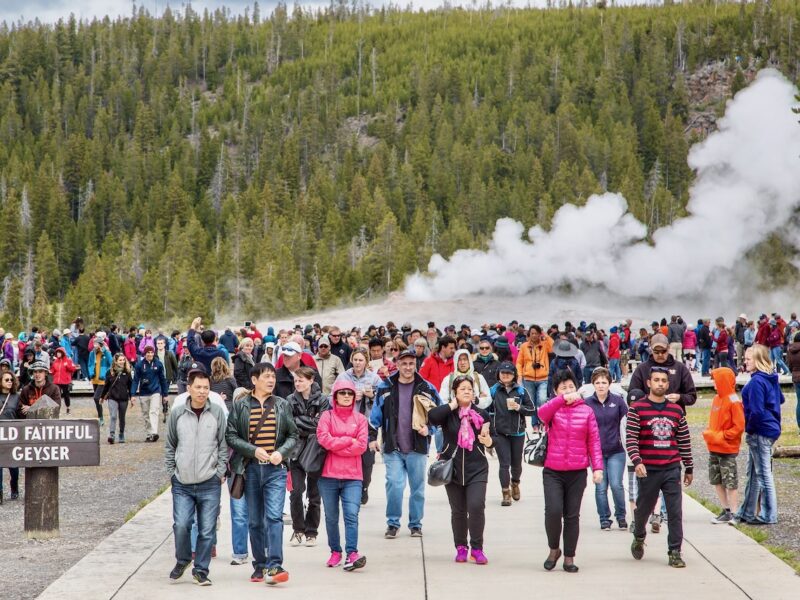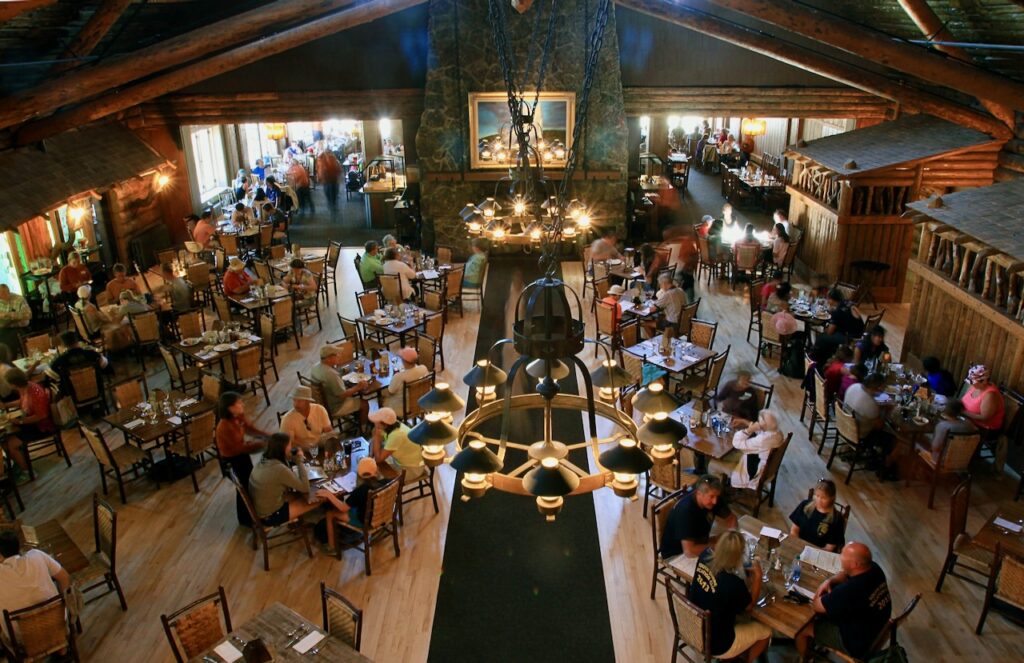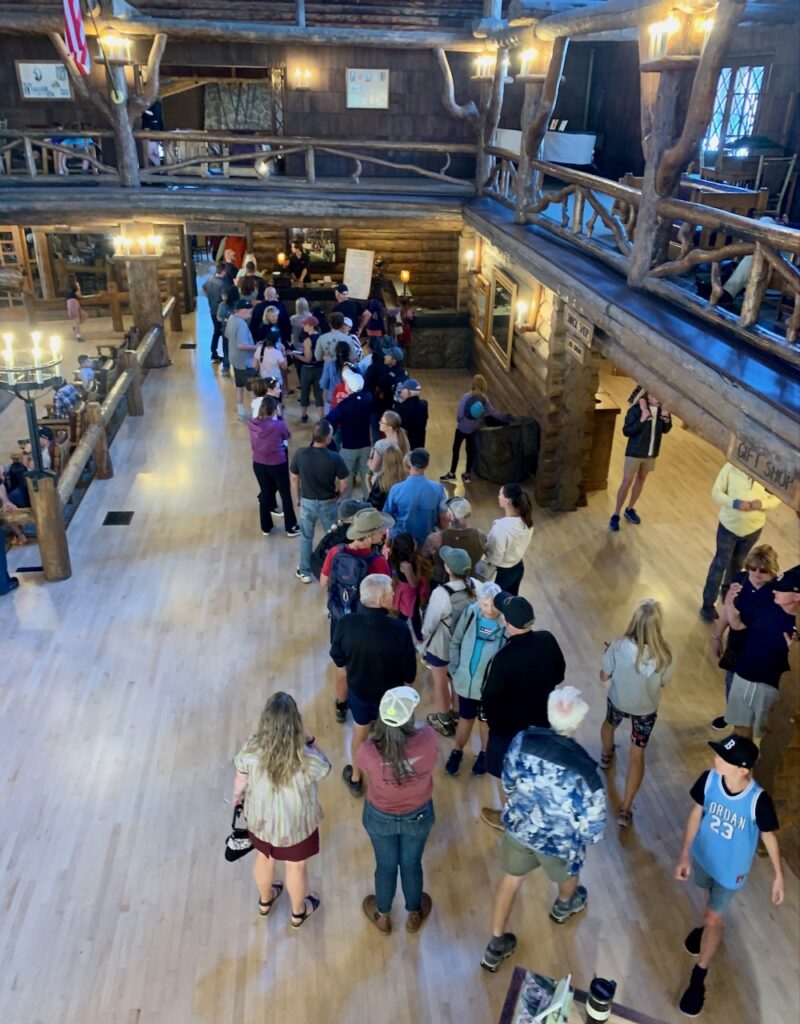Dining in the Back of Beyond (Part 1)
How Yellowstone concessioner serves 2M meals per year
- Published In: Other News & Features
- Last Updated: Sep 10, 2023

Dining venues around Old Faithful typically see a rush of hungry visitors when crowds disperse after an eruption. (Courtesy photo from National Park Service)
By Ruffin Prevost
Special to the Wyoming Truth
OLD FAITHFUL, Wyo. — The popular maxim that “an army marches on its stomach” was first attributed to Frederick the Great, the 18th Century King of Prussia, and later to Napoleon Bonaparte. While that adage encapsulates the challenges of feeding and equipping a military force, it could just as easily apply to feeding the summer hordes visiting Yellowstone National Park.
Especially after a mid-day eruption of Old Faithful Geyser in July.
July can see up to 1 million visitors to Yellowstone, and Old Faithful is the park’s most frequented spot. So when the geyser finishes its predictably timed show every 90 minutes or so, an army of hundreds of hungry visitors — sometimes thousands — expect to be fed.
Overseeing that battle is Lu Harlow, the commanding general in the ongoing skirmish against hunger in Yellowstone Park. Harlow is director of food and beverage operations for Xanterra Travel Collection, the park’s primary operator of hotels and restaurants, and the largest national and state park concessioner in the country.

“It’s definitely a challenge, and one that’s constantly changing and evolving,” Harlow said. “Historically, we serve over 2 million meals each year.”
Xanterra runs 23 eateries inside Yellowstone, ranging from small coffee shops and ice cream stands to sprawling cafeterias and white-tablecloth dining rooms.
Operating under a contract with the National Park Service, the company must provide competitively priced meals to visitors across a national park that is larger than Rhode Island and Delaware combined, drawing from suppliers often located hours away.
Complicating those challenges are the company’s pledge — and a mandate from the Park Service — to offer locally sourced, sustainably produced food whenever feasible. And unlike restaurants in big cities, most of Yellowstone’s dining venues are open only during the summer season, making recruiting, training and retaining staff a perennial headache.
Winter food deliveries
Some of the eateries at Mammoth Hot Springs, the park’s headquarters, are usually open in winter. But at Old Faithful Snow Lodge, the only other winter dining venue, every potato, paper napkin, bottle of ketchup or clove of garlic that isn’t stockpiled by early December must be brought in by snow coach or snowmobile, as the roads to Old Faithful are closed to wheeled vehicles in the winter.
During the busiest part of the summer, Xanterra’s primary vendor makes four deliveries each week. And Xanterra maintains three warehouses within the park to supply six separate developed areas connected by Yellowstone’s 153-mile Grand Loop Road.
One vendor based in Billings, Montana must have its trucks on the road early in the morning, Harlow said, to make deliveries through the park’s north entrance, or through West Yellowstone, which is a nearly four-hour, one-way trip of 230-miles.
But to truly understand the staggering challenges Harlow faces, it’s helpful to compare the scale of Xanterra’s food operations to other busy eateries outside the park.

Nathan Kardos, chef/owner of Trailhead, one of the busiest fine dining restaurants in Cody, said he serves a little over 300 combined lunch and dinner “covers,” or individual meals, on an average summer day. The Irma Hotel is open for three meals daily, including buffets, in Cody, Yellowstone’s largest gateway community. The Irma typically serves 1,000 to 1,250 covers daily during the summer, said co-owner Mike Darby. At peak times, that number can approach 1,500, he said.
The Old Faithful Inn, by comparison, may serve 2,500 covers in a single summer day. Canyon Lodge, Yellowstone’s busiest dining spot, sometimes serves over 3,700 daily covers. Multiply that across Xanterra’s nearly two dozen venues, and the numbers are astounding.
By the numbers
On average, Harlow said Xanterra serves on each summer day: 153 pounds of short ribs, 100 pounds of beef, 750 bison bratwursts, 780 hot dogs and 168 quarts of heavy whipping cream. Over the course of a summer, the company scoops out 24,000 gallons of ice cream.
Despite the complex logistics and massive quantities she deals with, Harlow said one of her primary struggles is employee housing, an issue often cited by Yellowstone Superintendent Cam Sholly as a main concern in park operations.
“It has now become one of our biggest challenges, and we would like to increase our housing exponentially,” Harlow said.
Some of Xanterra’s 2,700 summer employees can find housing in the Montana gateway towns of Gardiner or West Yellowstone. But workers at places in the park’s interior must live on site. However, building new housing is a costly, complex and time-consuming process governed by a thicket of federal environmental regulations and Park Service policies.
As with any battle plan, though, improvising and adapting are key to success. Harlow said the company has recently worked to add more suppliers who can make deliveries into the park, or even directly to kitchens, including Seattle Seafood, Montana Wheat and Quality Foods Distributing, a company based in Bozeman, Montana specializing in organic and natural products.
For Briana Jackson and Brandon Phelps, visiting Yellowstone last month from Kentucky, how their lunch was made didn’t matter as much as the taste, value and service.
Despite walking into the Old Faithful Inn dining room right after the geyser finished erupting, the two said they were seated within about 10 minutes for the $20 self-serve buffet, which they figured was faster than ordering a la carte from the menu.
“We had a little bit of everything: salmon, coleslaw, pulled pork,” said Jackson, who with Phelps had traveled to nearly 10 national parks over the past four months.
“I thought the food was really good, especially for the price,” Phelps said. “This was probably the best deal, as far as the quantity and quality of food for the price, of anywhere we’ve been so far this summer.”
Check back tomorrow for part 2.













